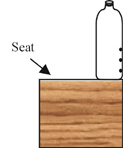Water flow
This task is about investigating water flow and pressure.

How to do this task:
- Collect a milk container and its top.
- Fill the container with water. Put on the top. Put your fingers over the holes. Carry it on its side so that it doesn’t spill.
- Set up the container with the holes facing away from the edge of the seat.
- Remove the top and take your fingers away.
| a) |
The water will begin to come out of the holes. On the diagram above draw how the water comes out of the three holes.
|
|
| b) | i) |
From which hole does the water travel further? ____________________
|
| ii) |
Why does water travel furthest from this hole?
|
|
| c) | i) |
Now refill the bottle with water and do the experiment again, but this time have the top on the bottle.
Write down what happens.
|
| ii) |
Explain why the water flow is different from before.
|
|

